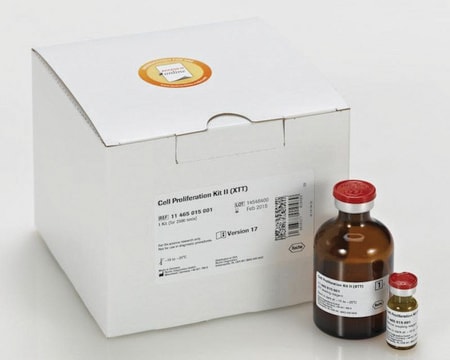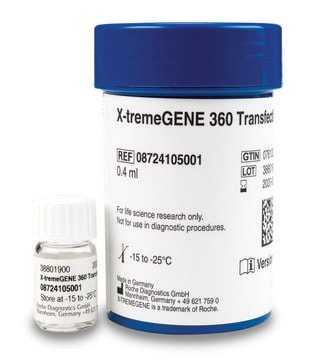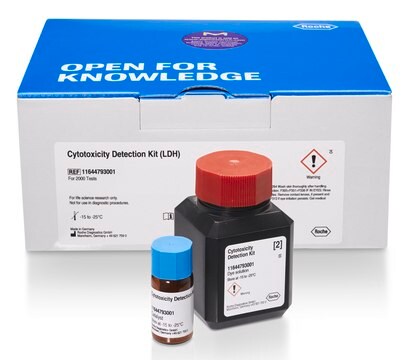Alle Fotos(1)
Wichtige Dokumente
PA0100
Plant Cell Viability Assay Kit
Fluorescent staining system to highlight viable and non-viable cells
Anmeldenzur Ansicht organisationsspezifischer und vertraglich vereinbarter Preise
Alle Fotos(1)
About This Item
UNSPSC-Code:
10171502
NACRES:
NA.84
Empfohlene Produkte
Qualitätsniveau
Lagertemp.
−20°C
Allgemeine Beschreibung
The Plant Cell Viability Assay Kit is designed for the differential viability staining of plant cells. The kit employs a dual color fluorescent staining system to highlight viable and non-viable cells. This procedure has been used to stain intact plant tissue, callus tissue, cell suspension culture, and protoplasts.
Anwendung
Viable cells are living cells with intact plasma membranes. These cells can be distinguished by the presence of intracellular esterase activity. This activity is assayed through the enzymatic hydrolysis of fluorescein diacetate or related compounds, such as carboxyfluorescein or calcein AM. These lipophilic compounds are membrane-permeable and non-fluorescent. In the plant cell, they are hydrolyzed to highly polar fluorescent compounds. Because of their polar nature, these compounds are unable to diffuse across the plasma membrane and are retained within viable cells, producing an intense green fluorescence within the cytoplasm. Fluorescein diacetate was found to be the optimal dye for staining viable plant cells. It does not photobleach as quickly as calcein AM, and produces much less background fluorescence than carboxyfluorescein diacetate in plant cells. Non-viable cells could be either living or dead. They can be distinguished from viable cells by their non-intact or damaged plasma membranes. Propidium iodide and related compounds, such as ethidium homodimers-1 and -III, can only enter cells with damaged membranes, whereupon they intercalate into double-stranded nucleic acids. This results in a bright red fluorescence in non-viable cells, particularly in the nucleus where the concentration of nucleic acids is highest. Propidium iodide is the optimal dye for staining non-viable plant cells. In plant cells it specifically labels nucleic acids, whereas ethidium homodimers-1 and -III both bind non-specifically to the plant cell wall.
Sonstige Hinweise
The components of this kit must be protected from light and stored at -20 °C with desiccant. Propidium iodide is stable in aqueous solution. However, fluorescein diacetate will hydrolyze in aqueous solution. Dilutions of the dyes should be used within one day.
Lagerklassenschlüssel
10 - Combustible liquids
WGK
WGK 2
Flammpunkt (°F)
188.6 °F
Flammpunkt (°C)
87 °C
Hier finden Sie alle aktuellen Versionen:
Besitzen Sie dieses Produkt bereits?
In der Dokumentenbibliothek finden Sie die Dokumentation zu den Produkten, die Sie kürzlich erworben haben.
Kunden haben sich ebenfalls angesehen
E A Brisibe et al.
Journal of experimental botany, 51(343), 187-196 (2000-08-12)
Three types of callus tissues established from anther culture of eleven doubled haploid (DH) lines of wheat (Triticum aestivum L.) were evaluated for their ability in enhancing friable embryogenic (Type II) culture differentiation and genetic transformation. Differences between types of
Estimating viability of plant protoplasts using double and single staining.
Huang, C.-N., et al.
Protoplasma, 135, 80-87 (1986)
H Koyama et al.
Journal of experimental botany, 52(355), 361-368 (2001-04-03)
The viability of Arabidopsis thaliana (strain Landsberg) roots exposed to a low pH (4.5 or 4.7) solution that contained 100 microM CaCl(2) was examined by staining with fluorescein diacetate-propidium iodide. The elongation zone of growing roots lost viability within 1-2
K H Jones et al.
The journal of histochemistry and cytochemistry : official journal of the Histochemistry Society, 33(1), 77-79 (1985-01-01)
A rapid, simultaneous double-staining procedure using fluorescein diacetate (FDA) and propidium iodide (PI) is described for use in the determination of cell viability in cell suspension. Air-dried slide preparations can be made from the cell suspensions so that an accurate
S. M. Regan et al.
The Plant cell, 2(9), 877-889 (1990-09-01)
Microsporogenesis has been examined in wild-type Arabidopsis thaliana and the nuclear male-sterile mutant BM3 by cytochemical staining. The mutant lacks adenine phosphoribosyltransferase, an enzyme of the purine salvage pathway that converts adenine to AMP. Pollen development in the mutant began
Unser Team von Wissenschaftlern verfügt über Erfahrung in allen Forschungsbereichen einschließlich Life Science, Materialwissenschaften, chemischer Synthese, Chromatographie, Analytik und vielen mehr..
Setzen Sie sich mit dem technischen Dienst in Verbindung.












